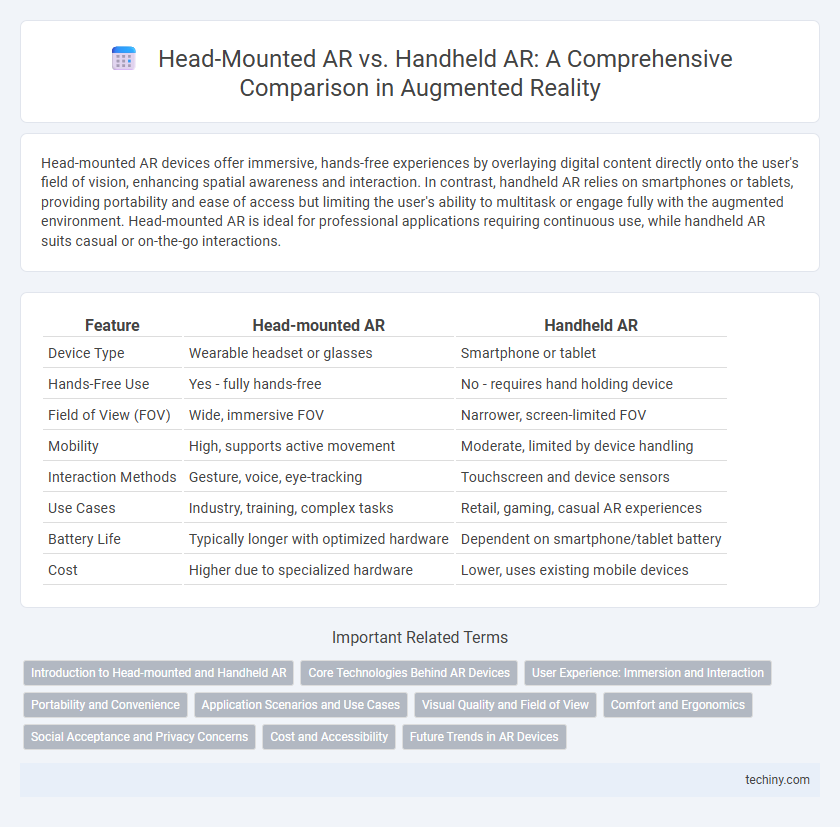Head-mounted AR devices offer immersive, hands-free experiences by overlaying digital content directly onto the user's field of vision, enhancing spatial awareness and interaction. In contrast, handheld AR relies on smartphones or tablets, providing portability and ease of access but limiting the user's ability to multitask or engage fully with the augmented environment. Head-mounted AR is ideal for professional applications requiring continuous use, while handheld AR suits casual or on-the-go interactions.
Table of Comparison
| Feature | Head-mounted AR | Handheld AR |
|---|---|---|
| Device Type | Wearable headset or glasses | Smartphone or tablet |
| Hands-Free Use | Yes - fully hands-free | No - requires hand holding device |
| Field of View (FOV) | Wide, immersive FOV | Narrower, screen-limited FOV |
| Mobility | High, supports active movement | Moderate, limited by device handling |
| Interaction Methods | Gesture, voice, eye-tracking | Touchscreen and device sensors |
| Use Cases | Industry, training, complex tasks | Retail, gaming, casual AR experiences |
| Battery Life | Typically longer with optimized hardware | Dependent on smartphone/tablet battery |
| Cost | Higher due to specialized hardware | Lower, uses existing mobile devices |
Introduction to Head-mounted and Handheld AR
Head-mounted AR devices, such as Microsoft HoloLens and Magic Leap, provide immersive, hands-free augmented reality experiences by overlaying digital content directly onto the user's field of vision. Handheld AR, commonly found in smartphones and tablets using platforms like ARKit and ARCore, offers more accessible and portable interactions by projecting augmented elements through the device's screen. Both forms of AR leverage real-time spatial mapping and computer vision technologies to enhance user engagement in gaming, training, and industrial applications.
Core Technologies Behind AR Devices
Head-mounted AR devices rely on advanced spatial mapping sensors, depth cameras, and waveguide displays to deliver immersive, hands-free experiences with precise environmental interaction. Handheld AR primarily integrates camera tracking, GPS, and IMU sensors within smartphones or tablets to overlay digital content on real-world scenes effectively. Both platforms leverage SLAM (Simultaneous Localization and Mapping) algorithms and real-time rendering engines, but head-mounted AR emphasizes low-latency processing and ergonomic design for extended use.
User Experience: Immersion and Interaction
Head-mounted AR devices provide a higher level of immersion by offering hands-free operation and a wider field of view, enhancing spatial awareness and natural interaction through gesture or voice controls. Handheld AR, while more accessible and versatile, often limits immersion due to its reliance on screen size and the need for manual device handling. The user experience in head-mounted AR is generally more seamless and engaging, making it ideal for complex tasks and continuous use.
Portability and Convenience
Head-mounted AR devices offer hands-free interaction and immersive experiences but tend to be bulkier and less portable than handheld AR, which relies on smartphones or tablets for ease of use and mobility. Handheld AR excels in convenience due to its lightweight design and widespread device compatibility, enabling quick access without additional equipment. However, head-mounted AR provides superior situational awareness and comfort during extended use, making it ideal for professional applications despite limited portability.
Application Scenarios and Use Cases
Head-mounted AR devices excel in immersive, hands-free applications ideal for industrial maintenance, medical surgery, and complex assembly tasks where real-time data visualization is critical. Handheld AR, often deployed via smartphones or tablets, suits more casual or on-the-go scenarios like retail visualization, educational content delivery, and location-based gaming. Both platforms drive innovative user experiences but differ fundamentally in ergonomics and interaction models, influencing their deployment across diverse sectors.
Visual Quality and Field of View
Head-mounted AR devices offer superior visual quality through integrated displays that provide higher resolution and brightness, enhancing immersive experiences compared to handheld AR, which relies on smartphone or tablet screens with limited brightness and resolution. The field of view (FoV) in head-mounted AR is significantly broader, often exceeding 50 degrees, enabling users to perceive digital content seamlessly aligned with their real world environment, while handheld AR typically provides a much narrower FoV constrained by the device's screen size. Enhanced FoV and visual fidelity in head-mounted AR contribute to more natural interactions and improved spatial awareness in augmented reality applications.
Comfort and Ergonomics
Head-mounted AR devices offer superior comfort for extended use through balanced weight distribution and hands-free operation, reducing physical strain compared to handheld AR systems. Handheld AR relies on continuous grip and arm elevation, often leading to fatigue during prolonged sessions. Ergonomic design advancements in head-mounted displays focus on adjustable straps and breathable materials to enhance user comfort.
Social Acceptance and Privacy Concerns
Head-mounted AR devices often face greater social acceptance challenges due to their conspicuous design, which can provoke privacy concerns related to continuous recording and facial recognition. Handheld AR, leveraging smartphones or tablets, tends to be more socially acceptable as it aligns with familiar device usage patterns and reduces fears of covert data capture. Privacy safeguards and transparent data policies remain critical for both formats to foster trust and widespread adoption.
Cost and Accessibility
Head-mounted AR devices typically involve higher costs due to advanced hardware like integrated sensors and displays, limiting accessibility for casual users and smaller businesses. Handheld AR leverages smartphones or tablets, significantly reducing expenses and increasing accessibility across various demographics and industries. Economies of scale in mobile device production further drive affordability, making handheld AR the preferred choice for widespread adoption.
Future Trends in AR Devices
Head-mounted AR devices are evolving towards lighter, more ergonomic designs with advanced display technologies like waveguides and eye-tracking for immersive, hands-free experiences. Handheld AR continues to integrate sophisticated sensors and AI-driven gesture recognition, enhancing spatial awareness and interactive capabilities on smartphones and tablets. Future trends emphasize seamless device convergence, improved battery life, and 5G connectivity to deliver real-time, high-fidelity augmented content across both form factors.
Head-mounted AR vs Handheld AR Infographic

 techiny.com
techiny.com